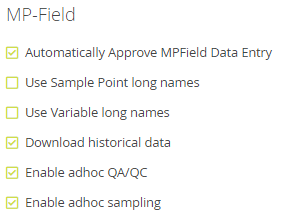- Knowledge Base and Manual
- MP-Field
- Updating in the Field
-
Installation
-
Integration
-
MP-Desktop
-
MP-Web
- Introduction
- Access
- Side Bar Navigation
- Dashboard
- Favourites
- Datasets
- Summary Tab
- Tables Tab
- Export Tab
- Graphical Tab
- Report Tab
- Mapping Tab
- Manual Data Entry
- Calendar Tab
- Action Plans
- Custom Forms
- Contacts and Alerts
- Compliance
- Task Scheduler
- Monitoring Scheduler
- Calculator
- Data Entry
- Email Importer
- Object Management
- Obligations
- Policies
- Administration
- Administration - Manage Users
- Administration - Datasets
- Administration - Internationalisation
- Administration - Email Importer
- Administration - Monitoring
- Administration - Advanced
- Culture
-
MP-Field
-
Release Notes
-
Reporting
-
Configuration
-
Trial and Demo
-
Monitoring Types
Updating Visits in the Field Introduction
How to make changes to a Visit in the field
MP-Field offers a number of options to update a Visit in the field. These updates can even be done in the field where there is no internet connection. This feature only supports Monitoring Schedules made using Sample Templates, this option will not be accessible where the Monitoring Schedule has been created using Sources and Variables. The settings can be turned on in MP-Web Administration and off by default. A system administrator will need to enable the ad-hoc QA/QC and ad-hoc sampling.

The options available can be broken out into:
QA/QC
QA/QC samples can be set from the Monitoring Schedule. Typically these are allocated at random based on a set percentage or number of samples per Visit, which need to be collected. The user in the field can either add additional QA/QC samples as required or they can choose to add them to different locations, perhaps where the prescribed location cannot be accessed or is dry.
Additional Samples
Similar to QA/QC it might be required to collect additional samples in the field which weren't prescribed in the routine schedule. This allows more dynamically for the collection and recording of Ad-hoc sampling such as spills.
Other examples can be where an unknown amount of sampling is to be collected or an unknown set of field analyses is to be recorded. This is typical for sampling at varying depths or for purging groundwater to obtain steady-state conditions.
Additional samples can be collected based upon different Sample Types or common Sample Types where Date/Time is used to differentiate the samples.
Additional Analysis
This option enables users in the field to capture additional analysis for existing samples.
